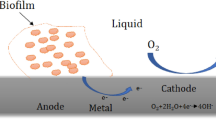Various corrosion monitoring methods are used in order to monitor the corrosion state of gas object equipment. The main parameter for evaluation is corrosion rate. In addition to the main gravimetric method, two more determination methods are used: an electrical resistance ER-method, and linear polarization resistance LPR-method. In the course of testing ER- and LPR-probes the possibility of their use in corrosive-aggressive conditions of hydrocarbon processing facilities, as well as the influence of various factors on the data obtained for corrosion rate are evaluated.



Similar content being viewed by others
References
A. V. Prokopov, V. A. Istomin, D. M. Fedulov, and A. G. Dedov, “Increasing the efficiency of hydrocarbons C5+ extraction from the gas of condensate fields by a low temperature absorption process,” Theor. Found. Chem. Eng., 53, No. 5, 886 (2019).
R. K. Vagapov and D. N. Zapevalov, “Corrosion activity of operating conditions for the steel equipment and pipelines in the plants extracting CO2 -containing gases,” Metallurgist, 65, No. 1-2, 50–61 (2021).
V. V. Burov, “Contemporary approaches to resolving the problem of protecting OPP equipment fro corrosion,” Neft. i Neftekhimi, Nauch. Tekhn. Dost Pered. Opyt., No. 3, 64–68 (2013).
A. Yu. Koryakin, V. F. Kobeychev, V. V. Aleksandrov, et al., “Experience of modernizing production equipment for gas preparation of the Achimov gas deposit of the Urengoi oil and gas condensate deposits,” Gaz. Prom. Special issue, No. 1, 64–70 (2009).
M. L. Medvedeva and V. V. Gur’yanpov, “Corrosion condition of installations for natural gas purification from acid components,” Zashch. Met., 38, No. 3, 322–326 (2002).
D. S. de Freitas, I. L. M. Gonçalves, and G. I. Vaz, “The effect of ethanol added to the natural gas stream on the top of line corrosion: An approach on vapor phase condensation and carbonic acid generation yield,” J. Natural Gas Science and Engineering, 96, Art. 104297 (2021).
R. K. Vagapov, “Comparing and interpreting results of processing in-line inspection data for corrosive gas transportation conditions,” Russian Journal of Nondestructive Testing, 57, No. 8, 717–726 (2021).
GОSТ 9.514-99. ЕSZКS. Metal Corrosion Inhibitors for Aqueous Systems. Electrochemical Method for Determining Protective Capacity.
GOST Р 9.905-2007. ЕSZKS. Corrosion Test Method. General Requirements.
R. K. Vagapov and I. S. Tomskiy, “Dependence of corrosion process rate on carbon dioxide medium containing flow rate,” Chemical and Petroleum Engineering, 57, No. 5-6, 507–512 (2021).
Y. Chen, M. Gopal, and W. P. Jepson, “Comparison of ECN and EIS measurement for corrosion monitoring under multiphase flow conditions,” in: NACE Corrosion Conference (1997), Paper 276.
R. K. Vagapov, R. R. Kantyukov, and D. N. Zapevalov, “Internal corrosion and anticorrosion protection of offshore facilities in the presence of increased amounts of carbon dioxide,” Intern. J. Corrosion and Scale Inhibition, 10, No. 3, 1128–1140 (2021).
R. K. Vagapov, R. R. Kantyukov, and D. N. Zapevalov, “Investigation of the corrosiveness of moisture condensation conditions at gas production facilities in the presence of CO2 ,” Intern. J. Corrosion and Scale Inhibition, 10, No. 3, 994–1010 (2021).
C. Torres, C. Costa, A. Pereira, et al., “Corrosion failure analysis in a biodiesel plant using electrical resistance probes,” Engineering Failure Analysis, 66, 365–372 (2016).
Author information
Authors and Affiliations
Corresponding author
Additional information
Translated from Khimicheskoe i Neftegazovoe Mashinostroenie, Vol. 58, No. 4, pp. 38−41, April, 2022.
Rights and permissions
Springer Nature or its licensor holds exclusive rights to this article under a publishing agreement with the author(s) or other rightsholder(s); author self-archiving of the accepted manuscript version of this article is solely governed by the terms of such publishing agreement and applicable law.
About this article
Cite this article
Vagapov, R.K., Ibatullin, K.А. & Yarkovoi, V.V. Comparison of Corrosion Monitoring Instrument Methods for Hydrocarbon Processing Object Conditions. Chem Petrol Eng 58, 328–333 (2022). https://doi.org/10.1007/s10556-022-01095-z
Published:
Issue Date:
DOI: https://doi.org/10.1007/s10556-022-01095-z




